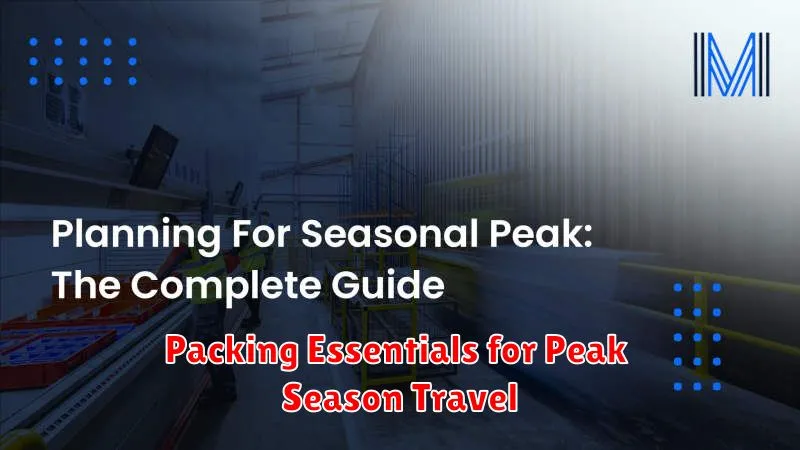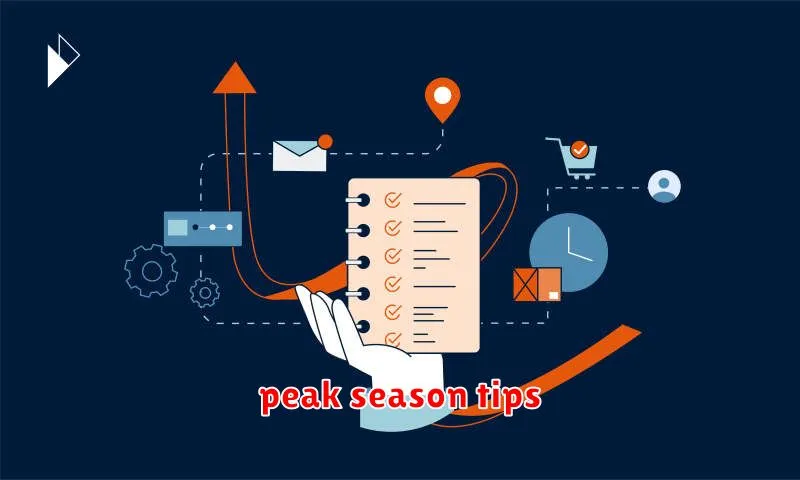Planning a trip during peak season? Don’t let the crowds scare you! With a little planning, you can still have an amazing vacation even when everyone else is traveling. This guide offers 10 essential tips for traveling during peak seasons, helping you navigate higher prices, larger crowds, and potential booking challenges. Learn how to snag the best deals, find less crowded spots, and make the most of your peak season travel experience. Get ready to explore the world, even during the busiest times of the year!
How to Avoid Crowded Tourist Attractions

Peak season travel means battling crowds at popular destinations. To escape the throngs, consider visiting lesser-known attractions within the same region. Instead of the Eiffel Tower, explore the charming Montmartre district in Paris. Instead of the Colosseum, delve into the hidden gems of the Roman Forum.
Timing is key. Arrive early in the morning or late in the afternoon when buses and tour groups are less prevalent. This applies to both popular landmarks and smaller attractions. Plan your sightseeing strategically, avoiding the busiest hours.
Embrace the off-season (if possible!). While peak season boasts ideal weather, shoulder seasons (spring and fall) offer fewer crowds and potentially better deals on flights and accommodations. Even a slight shift in your travel dates can make a significant difference.
Consider alternative transportation. Skip the hop-on-hop-off bus tours – they often concentrate on the most popular spots and contribute to overcrowding. Opt for walking, cycling, or using public transportation to explore at your own pace and discover hidden alleys.
Book in advance. For highly sought-after sites like museums or historical landmarks, pre-booking tickets online eliminates long queues and ensures entry. This simple step significantly reduces time spent waiting in line.
Booking Accommodations Early

Peak seasons mean higher demand and limited availability for accommodations. Booking early is crucial to securing your preferred lodging, whether it’s a hotel, Airbnb, or vacation rental. The best options often sell out months in advance, especially in popular tourist destinations.
Early booking not only guarantees you a place to stay but also often allows you to take advantage of better rates. While last-minute deals sometimes exist, they’re less common during peak seasons, and you’ll likely pay a premium for the convenience.
Don’t wait until the last minute! Start your accommodation search as early as possible, ideally several months before your trip, to avoid disappointment and inflated prices. This is one of the most effective ways to ensure a smooth and stress-free vacation during peak travel times.
How to Find Quiet Spots in Popular Destinations
Traveling during peak season offers unique challenges, especially when it comes to finding peace and quiet amidst the crowds. However, with a little planning and some insider knowledge, you can discover hidden gems even in the most popular destinations.
Venture beyond the main attractions: Most tourists stick to the well-known sights. Explore lesser-known neighborhoods, parks, or hiking trails just outside the bustling tourist centers. Local maps and guides can be invaluable resources here.
Embrace off-peak hours: Popular spots are often less crowded in the early morning or late evening. Consider visiting iconic landmarks outside of the usual tourist rush to experience them with fewer people around.
Utilize public transportation: Driving can be a nightmare during peak season. Public transportation often provides access to quieter areas that are harder to reach by car and allows you to observe local life away from the main tourist areas.
Seek out local experiences: Engage with local culture by participating in activities away from the major tourist hubs. Consider attending local events, visiting smaller museums, or taking a cooking class – you’ll likely discover serene, less-crowded spots along the way.
Ask the locals: Don’t underestimate the power of local knowledge. Hotel staff, shopkeepers, and even fellow travelers can point you towards hidden gems and quieter alternatives to the well-trodden paths. They often know the best-kept secrets!
Consider alternative accommodations: Instead of staying in a bustling city center hotel, explore options in quieter suburbs or nearby towns. This offers a more peaceful base from which to explore.
Book in advance (strategically): While booking accommodations and tours in advance is essential during peak season, also consider scheduling activities for less busy times or choosing less popular options within a given attraction.
Pack for comfort and solitude: Bring a good book, headphones, and a portable charger so you can easily find a quiet spot to relax and recharge even amidst the crowds. Sometimes, escaping the hustle is as simple as finding a comfortable bench in a less busy park.
Be flexible: The key to finding quiet spots during peak season is flexibility. Be open to adjusting your plans and embracing spontaneity. Sometimes the most rewarding experiences come unexpectedly when you venture off the beaten path.
Using Local Insights to Navigate Busy Areas
Peak seasons mean crowds. To avoid feeling overwhelmed, tap into local knowledge. Instead of relying solely on tourist maps, consider asking your hotel concierge or local shopkeepers for advice on less crowded routes, hidden gems, and alternative transportation options.
Local apps and online forums can also be invaluable. Search for recommendations on quieter restaurants, less-trafficked attractions, or even the best times to visit popular sites to minimize wait times. These insider tips can transform your experience from stressful to enjoyable.
Don’t underestimate the power of conversation. Engage with locals – a friendly chat with a barista or taxi driver can lead to unexpected discoveries and shortcuts, avoiding the busiest thoroughfares and helping you navigate with ease.
By proactively seeking out local perspectives, you can significantly improve your experience navigating busy tourist areas during peak season, allowing you to enjoy the destination more fully rather than being frustrated by the crowds.
Tips for Flexible Itineraries During Peak Seasons
Peak season travel means higher prices and more crowds. To combat this, embrace flexibility in your itinerary. Instead of rigidly scheduling every activity, build in buffer days and alternative options.
Consider a range of dates for your trip, rather than locking into specific days. Websites like Google Flights allow you to search for the cheapest flights within a given month. This flexibility can significantly impact your overall cost.
Prioritize your must-do activities, but leave room for spontaneity. If a particular attraction is overcrowded, be prepared to pivot to a different activity or visit at a less busy time of day.
Research alternative destinations within your chosen region. If your dream location is packed, a nearby, equally charming town might offer a similar experience with fewer crowds.
Book accommodations that allow for some flexibility. Look for hotels or rentals with free cancellation policies in case your plans change. Consider alternative accommodation types like Airbnb for potentially better value and more space.
Remember, a flexible itinerary isn’t about giving up on your travel plans; it’s about maximizing your enjoyment by adapting to unexpected circumstances and potentially saving money in the process. Embrace the unexpected, and you might just discover hidden gems along the way!
How to Save Money Despite High Demand
Traveling during peak season often means higher prices. However, with a little planning, you can still save money despite the high demand. One key strategy is to be flexible with your travel dates. Shifting your trip by just a few days, even a week, can significantly reduce costs. Consider traveling mid-week instead of weekends, as prices are often lower.
Another important aspect is choosing your destination wisely. While popular destinations are tempting, explore less-crowded alternatives that offer similar experiences at a lower price. Researching lesser-known attractions and activities can also lead to significant savings.
Booking in advance is crucial, but it doesn’t always mean paying top dollar. Set up price alerts on flight and accommodation comparison websites to track price fluctuations. Consider booking flights and accommodation separately, as this can sometimes be cheaper than package deals, especially during peak season.
Don’t underestimate the power of budget-friendly accommodation options. Explore hostels, guesthouses, or vacation rentals instead of luxury hotels. These alternatives can drastically reduce your accommodation costs without compromising your overall travel experience.
Finally, be mindful of your spending habits while traveling. Pack snacks and drinks to avoid expensive tourist traps. Utilize free activities like hiking, exploring parks, or visiting free museums. By being resourceful and planning ahead, you can significantly reduce your overall travel expenses, even during peak season.
The Best Time to Visit Popular Landmarks
Navigating peak seasons requires strategy, and a key element is timing your visits to iconic landmarks. Shoulder seasons (spring and fall) often offer the sweet spot. Crowds are smaller than in the summer, the weather is usually pleasant, and you can often find better deals on accommodation.
For specific landmarks, research is crucial. The Eiffel Tower in Paris, for example, sees fewer crowds in the spring and autumn months compared to the busy summer. Similarly, popular national parks in the US might be less crowded in the shoulder seasons or even during the off-season, depending on their location and climate. Consider the specific climate of your chosen destination; some locations are simply unbearable during summer months.
Early mornings and late evenings are also valuable times to visit popular attractions regardless of the season. You’ll beat the rush and enjoy a more tranquil experience. By strategically planning your visits around peak hours, you can significantly enhance your sightseeing enjoyment during peak travel times.
Remember to check the specific landmark’s website for any seasonal closures or events that may affect your visit and always consider potential weather conditions that may impact your trip. This preparation will ensure you make the most of your time at these iconic locations even during the busiest times of year.
Packing Essentials for Peak Season Travel

Peak season travel means crowds and potential for unpredictable weather. Packing smart is crucial for a smooth trip. Your essentials should prioritize versatility and efficiency.
Lightweight clothing is key. Opt for quick-drying fabrics that can be layered. Pack neutral colors that can be mixed and matched, minimizing the number of items you need. Don’t forget comfortable walking shoes – you’ll likely be doing a lot of it!
Essential documents should be kept secure and readily accessible. This includes your passport, visa (if needed), flight/train tickets, and travel insurance information. Consider scanning copies and storing them separately in the cloud.
Toiletries should be travel-sized and in leak-proof containers. Remember any necessary prescription medications and a basic first-aid kit. A reusable water bottle is also a must-have to stay hydrated.
Finally, don’t forget the smaller but essential items: a portable charger for your electronics, a universal adapter (if traveling internationally), a small backpack for day trips, and any necessary entertainment (book, e-reader, etc.). Packing cubes can help you stay organized and maximize your space.
By packing strategically, you can travel light, stay comfortable, and enjoy your peak season trip without the unnecessary stress of overpacking or forgetting essential items.
Avoiding Long Lines at Airports
Peak travel seasons mean longer lines at airports. To minimize your wait times, consider these strategies:
Check-in online: Many airlines allow online check-in, saving you valuable time at the airport counter. This often lets you select your seat and print your boarding pass in advance.
Utilize TSA PreCheck or Global Entry: These expedited screening programs significantly reduce wait times at security checkpoints. The application process is straightforward and worth the investment for frequent travelers.
Arrive early: Even with online check-in and TSA PreCheck, arriving early is crucial, especially during peak seasons. Unexpected delays can still occur.
Pack smart: Pack your carry-on efficiently to speed up the security screening process. Familiarize yourself with TSA guidelines regarding prohibited items to avoid delays.
Use self-service kiosks: Many airports offer self-service kiosks for checking bags and printing boarding passes, further reducing your time spent in line.
Consider off-peak travel times: If possible, adjust your flight schedule to avoid peak travel times, such as early mornings and evenings.
Stay informed: Monitor your airline’s website and the airport’s website for real-time updates on wait times and potential delays.
Download airport apps: Many airports have apps that provide real-time information on security wait times, flight status, and other useful information.
Be prepared: Have all your travel documents readily available, including your boarding pass and identification. This will streamline the check-in and security processes.
How to Stay Calm in Overcrowded Places
Peak season travel means facing crowds. Feeling overwhelmed is completely normal! To stay calm, remember to breathe deeply and practice mindfulness. Focus on your breathing, noticing the sensation of the air entering and leaving your body.
Plan ahead as much as possible. Knowing your route and having tickets or reservations ready minimizes stress-inducing surprises. Having a backup plan also helps alleviate anxiety.
Set realistic expectations. Accept that delays and long lines are likely. Instead of getting frustrated, use this time to catch up on reading, listen to a podcast, or simply observe your surroundings. Consider it a chance to appreciate the people and atmosphere around you, rather than a stressful situation.
Limit your belongings. Carrying fewer items makes navigating crowded spaces much easier and reduces the chance of losing something important, further reducing stress. A small backpack or shoulder bag is more manageable than a large suitcase.
Give yourself breaks. Find a quiet spot to rest if you start to feel overwhelmed. Even a few minutes of quiet can help you regain your composure. Remember to stay hydrated and eat light snacks to maintain your energy levels.
Remember your purpose. Remind yourself why you’re traveling and focus on the positive aspects of your trip. Keeping your goals in mind can help you stay motivated and maintain a positive attitude.
Practice self-compassion. Don’t beat yourself up if you feel stressed. Everyone feels overwhelmed sometimes. Allow yourself to feel your emotions without judgment and focus on self-soothing techniques.

